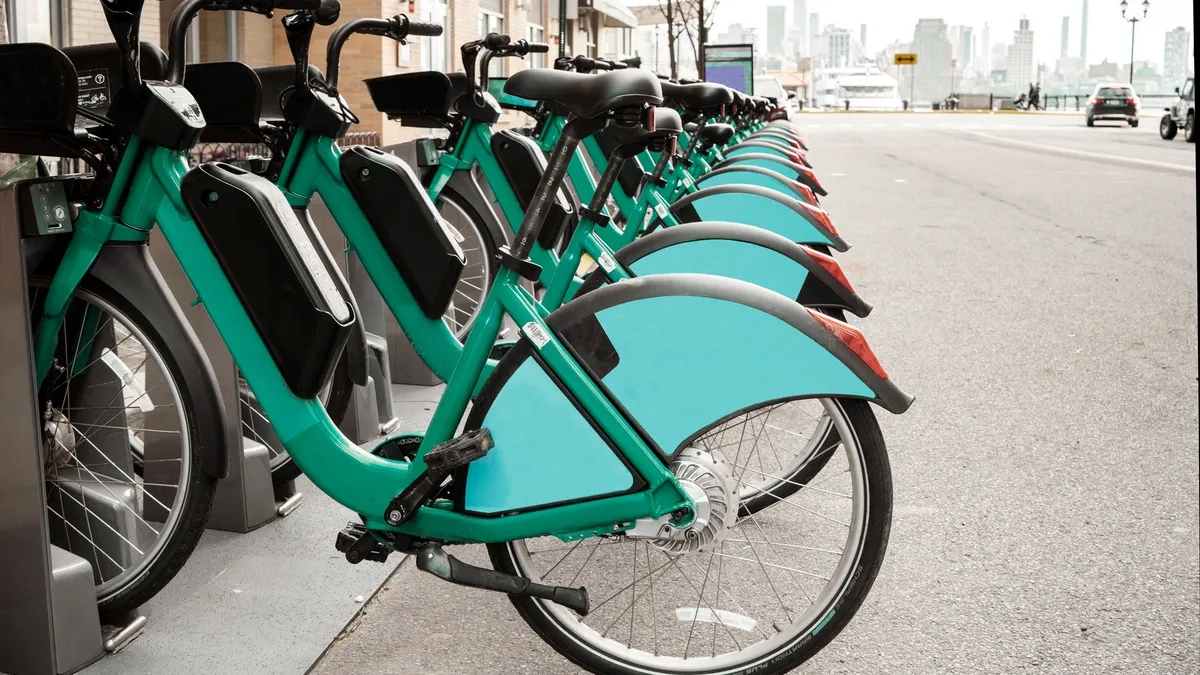This article is part of Smart Cities Dive’s 2023 Outlook series. A roundup of all the articles is available here.
The micromobility space confronted both opportunities and obstacles in 2022. While ridership grew, a number of shared micromobility providers faced economic challenges that shook up the industry. The coming year could see those issues escalate, even if micromobility proves to be the future of urban transportation, according to researchers and transportation professionals.
Indeed, the federal government recognizes micromobility’s role in the transition to a clean energy future. Earlier this month, the Biden administration released a blueprint for transportation decarbonization that names investment in micromobility as a critical policy.
In 2023, “we’re going to see a huge increase in micromobility ownership and usage, which includes subscriptions and shared [services],” said Wei Fan, director of the University of North Carolina at Charlotte’s Center for Advanced Multimodal Mobility Solutions and Education. Fan credits the semiconductor shortage, rising energy prices and growing eco-consciousness as forces behind the shift. But cities must address accessibility and infrastructure concerns to ensure micromobility’s success, researchers and transportation professionals said.
Electrification will continue to expand
Over the past few years, electric bike purchases have soared. David King, associate professor of urban planning at Arizona State University, said that local and state incentives could spur more e-bike sales in the U.S., especially if e-bike prices continue to rise. He pointed to Denver’s e-bike rebate program, which allows residents to save up to $1,200 on an e-bike purchase. King said he “expect[s] more cities to follow suit.”
The electrification trend matters for shared micromobility, too, said Samantha Herr, executive director of the North American Bikeshare & Scootershare Association. As cities increasingly build out electric vehicle charging infrastructure, officials should include infrastructure for micromobility as part of these projects, she said.
Will shared micromobility companies continue to struggle?
Last year, shared micromobility companies faced a flurry of trials, but it’s unclear if those issues will persist since much of it is beyond their control. Micromobility executives have blamed recession fears, inflation, a lack of venture capital funding, and regulatory challenges for 2022’s troubles.
“The era of free or cheap money — is probably at an end,” King said. Consequently, companies will prioritize profitability and shrink their footprints, he said.
But even if shared micromobility operators leave a city, “there’s now a well-known and obvious substitute for these services—which is you go buy your own scooter or electric bike,” King said.
However, shared micromobility ridership will increase in 2023, Herr said. “I am sure of that,” she added. Shared micromobility ridership rose between 2020 and 2021 and likely increased in 2022, Herr said. But nationwide data is not available yet.
According to Herr, the issues seen in 2022 may continue into 2023, but shared micromobility is “still a pretty young industry,” and therefore, “you’re going to have flux and change…as the industry adjusts and matures.”
To alleviate some of these growing pains, many cities are moving toward creating “more stable environments” for both micromobility providers and city residents,” said Alex Engel, senior communications manager at the National Association of City Transportation Officials. For instance, cities may only allow a few providers to operate instead of allowing a “free for all” of dockless vehicles or focus more on public-private partnerships like many bikeshare services, Engel said.
Cities will confront questions about accessibility
Partly because shared micromobility providers focus on profitability, the past few years have seen a rapid increase in trip prices. According to a report by NACTO, shared scooter and e-bike trip prices have more than doubled since 2018.
“One thing we’re looking to see in the year ahead is how cities manage some of these pressures,” Engel said. Some shared micromobility trips have actually become more expensive than a comparable trip taken in a shared vehicle like Uber or Lyft, he added. Higher prices could push riders away from shared micromobility, especially the poorest riders, who use shared micromobility less than the public as a whole. According to the report, prices have increased the most in cities that do not regulate shared micromobility.
City leaders should prioritize safe infrastructure
Researchers and transportation professionals emphasize that safe infrastructure is crucial for micromobility’s future. Safe infrastructure means “actually creating safe spaces on the roads for people to ride,” Herr said. King agreed, noting that “you’re not going to see sustained growth in usage unless [cities] dramatically improve the infrastructure.”
Fan is confident that local governments will improve micromobility infrastructure. “Cities are going to shift from car-dominated mindsets,” he said, reallocating roads and parking spaces to support infrastructure like protected bike lanes.
King, however, doesn’t expect broad national trends in micromobility adoption. He said some places, like college campuses, will excel, while others will face more challenges. “Even sustained investment in safe infrastructure,” King said, “is not going to be enough to get suburban drivers out of their cars necessarily.”


















